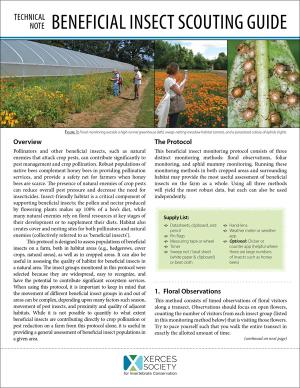
Insect-friendly habitat is a critical component of supporting beneficial insects; the pollen and nectar produced by flowering plants makes up 100% of a bee’s diet, while many natural enemies rely on floral resources at key stages of their development or to supplement their diets. Habitat also creates cover and nesting sites for both pollinators and natural enemies (collectively referred to as ‘beneficial insects’).
This protocol is designed to assess populations of beneficial insects on a farm, both in habitat areas (e.g., hedgerows, cover crops, natural areas), as well as in cropped areas. It can also be useful in assessing the quality of habitat for beneficial insects in a natural area.
This beneficial insect monitoring protocol consists of three distinct monitoring methods: floral observations, foliar monitoring, and aphid mummy monitoring. Running these monitoring methods in both cropped areas and surrounding habitat may provide the most useful assessment of beneficial insects on the farm as a whole. Using all three methods will yield the most robust data, but each can also be used independently.
